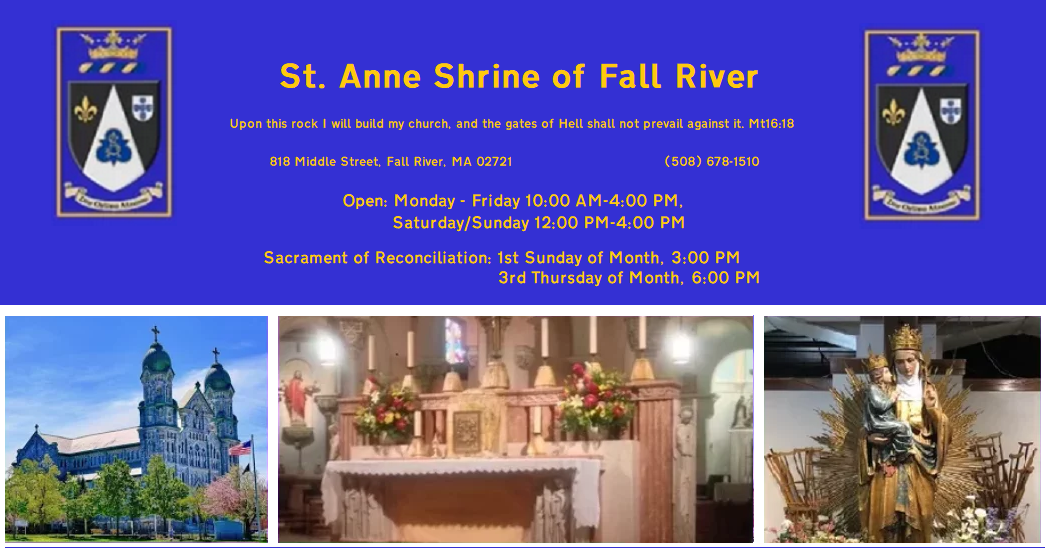From the November 25, 2018 issue of the Fall River Herald News and reprinted with permission.
- The stone marked “Pierre De Ste. Anne Jerusalem” that stands before the statue of St. Anne in the lower shrine is from St. Anne’s Church in Bethesda, Jerusalem. A crusader church built between 1131 and 1138 AD, St. Anne’s was built over the traditional site of the birthplace of Anne, mother of Mary. Many who were blind, disabled, lame, and paralyzed were said to have been healed there. People make pilgrimages to St. Anne’s in Jerusalem to this day. Next to the church is the Bethesda Pool, where Jesus was said to have healed a paralytic (John 5:1-15).
- The first miracle at St. Anne’s Church in Fall River: Fr. Adrien de Montaubricq of Bordeaux, France came to the city in 1869 to help form the first French-speaking parish. On March 20, 1870, when the first cornerstone (on Hunter St.) was being blessed, he and some 100 parishioners standing on the platform were injured when it collapsed. He prayed to St. Anne for aid and to help him recuperate so he could carry on building the church. In return, he promised St. Anne his church would be dedicated to her. The church was named St. Anne’s and opened two months later.
- Belgian sculptor Maestro Stalzenburg was commissioned by St. Anne’s Church to carve a statue of St. Anne from a single block of wood. It was received in 1893 and sent to Chicago for public display at the World’s Fair. It resided in the upper church until 2019, when it was temporarily relocated to the Cathedral.
- Saint Concorde, the wax statue in the shrine, along with relics from the Catacombs of Priscilla in Rome, was among the prized possessions of the shrine’s Dominican founders who fled France and came here as refugees in 1893. St. Concorde died a martyr in 258 AD when she was flogged to death for becoming a Christian.
- The original windows in St. Anne’s Church were made of simple colored glass to keep costs down when the church was built. They were replaced with stained glass by E. Rault of Rennes, France and set between 1959 and 1961, and are considered the largest installation of faceted stained glass in the U.S..
- As a shrine, St. Anne’s is considered to be a privileged center of divine favor, and a special place where God favors those who come from great distances to pray. Because St. Anne was the mother of Mary and grandmother of Jesus, she is thought to be the object of God’s special favor.
- The first Mass was celebrated in the lower church shrine on Christmas Day in 1895. Construction of the upper church was halted until 1902. The upper church was dedicated on July 4, 1906. The original church was founded in 1869 at the corner of Hunter and William Streets.
- From 1902 forward, special devotions were made to St. Anne. Pilgrims from parishes near and far organized groups of 500 to 1,000 and made an annual pilgrimage to St. Anne’s Church on foot, by rail, and by boat.
- The marble altar and baptismal font in the upper church was imported from Italy in the late 1950s.
- There are three priests entombed in St. Anne’s Shrine. Buried there are Fr. Sauval, who arrived in Fall River as a French Dominican on November 22, 1887 at the age of 39, and took on the project in 1892 to build the grand St. Anne’s Church on South Main; Fr. Marchildon, known as the “Apostle” of St. Anne’s Shrine, and known to have touched thousands with his kindness and compassion; and Fr. Terrien, who was instrumental in establishing St. Anne’s School.
- The Fall River Diocese purchased St. Anne’s Church from the Dominican Fathers of the Canadian Province in the 1970s for $1.00 when the Dominicans could no longer staff the church. Fr. John Folster, a diocesan priest, was the first secular cleric named as pastor.
- When St. Anne’s Church was dedicated in 1906, some 2,000 people attended the ceremony, according to Herald News archives. It boasted 50 to 600 families at the time. Weekend Mass attendance declined over time from 1300+ in 1992 to 1100+ in 2002, down again to 485 in 2013, and to 378 in 2017, according to the diocese.
- St. Anne’s was built using local granite and Vermont blue marble. Faberge egg-shaped bell towers rise 155 feet above ground. The cost to build such a structure today would amount to $80 to $100 million dollars according to architect Tony Dias.
- The shrine underwent a $250,000 restoration effort in 2007 using funds collected by the St. Anne’s Shrine Historical Restoration Committee. Before that, some work had been done in the 1960s and 1990s.
- The letters D.O.M. carved into the facade of the church are Latin for “Deo Optimo Magnifico,” translated “Only the best for God.”
- St. Anne’s Church, built with donations from the French Canadian population in Fall River, was the first French parish in southeastern Massachusetts and the second Catholic church in Fall River, according to Herald News archives. It is on the National Register of Historic Places and has been considered a national shrine to the mother of Mary since 1892.
